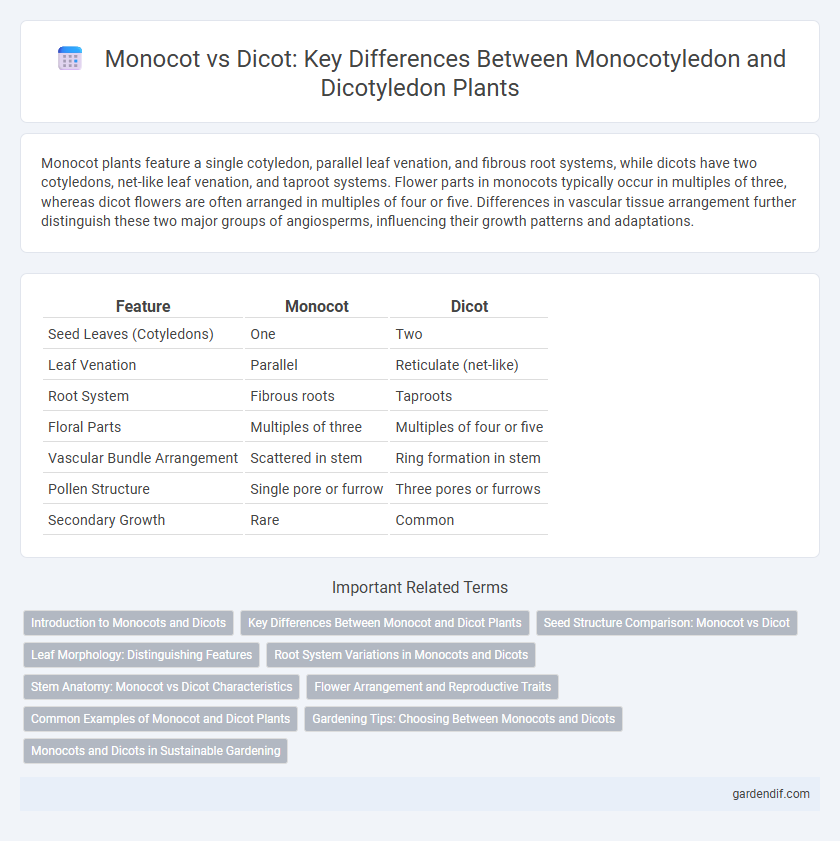
Monocot vs Dicot Illustration
Monocot plants feature a single cotyledon, parallel leaf venation, and fibrous root systems, while dicots have two cotyledons, net-like leaf venation, and taproot systems. Flower parts in monocots typically occur in multiples of three, whereas dicot flowers are often arranged in multiples of four or five. Differences in vascular tissue arrangement further distinguish these two major groups of angiosperms, influencing their growth patterns and adaptations.
Table of Comparison
| Feature | Monocot | Dicot |
|---|---|---|
| Seed Leaves (Cotyledons) | One | Two |
| Leaf Venation | Parallel | Reticulate (net-like) |
| Root System | Fibrous roots | Taproots |
| Floral Parts | Multiples of three | Multiples of four or five |
| Vascular Bundle Arrangement | Scattered in stem | Ring formation in stem |
| Pollen Structure | Single pore or furrow | Three pores or furrows |
| Secondary Growth | Rare | Common |
Introduction to Monocots and Dicots
Monocots and dicots represent the two primary classifications of angiosperms based on seed structure, with monocots having one cotyledon and dicots possessing two. Monocots typically exhibit parallel leaf venation, fibrous root systems, and floral parts in multiples of three, whereas dicots display net-like leaf venation, a taproot system, and floral parts usually in multiples of four or five. These fundamental differences underpin key variations in growth patterns, anatomical structures, and reproductive strategies among flowering plants.
Key Differences Between Monocot and Dicot Plants
Monocot plants have one cotyledon, parallel leaf venation, and floral parts in multiples of three, while dicot plants possess two cotyledons, net-like leaf venation, and floral parts typically in multiples of four or five. Monocots exhibit scattered vascular bundles in the stem, whereas dicots feature vascular bundles arranged in a ring. Root systems differ, with monocots developing fibrous roots and dicots usually forming a primary taproot.
Seed Structure Comparison: Monocot vs Dicot
Monocot seeds contain a single cotyledon that stores food and helps in nutrient absorption during germination, while dicot seeds have two cotyledons that often serve as the initial leaves of the seedling. Monocots typically feature a thin seed coat and a large endosperm that provides nourishment, whereas dicots usually show a thicker seed coat with reduced endosperm as nutrients are absorbed by the cotyledons. The vascular tissue arrangement in monocot seeds is scattered, contrasting with the organized ring pattern found in dicot seeds, reflecting fundamental differences in embryonic development.
Leaf Morphology: Distinguishing Features
Monocot leaves typically exhibit parallel venation, characterized by veins running side by side without intersecting, while dicot leaves feature a reticulate venation pattern with a network of interconnected veins. Monocot leaves usually have a sheathing base that wraps around the stem, whereas dicot leaves are attached directly by petioles without a sheath. These distinct morphological traits in leaf venation and attachment serve as primary indicators for differentiating monocotyledonous and dicotyledonous plants in botanical classification.
Root System Variations in Monocots and Dicots
Monocots exhibit a fibrous root system characterized by numerous thin roots emerging from the stem base, providing extensive soil anchorage and nutrient absorption. Dicots typically develop a taproot system dominated by a single, thick primary root that grows vertically downward with smaller lateral roots branching off, enabling deep soil penetration and enhanced water access. These root system variations influence plant stability, nutrient uptake efficiency, and adaptability to diverse environmental conditions.
Stem Anatomy: Monocot vs Dicot Characteristics
Monocot stems feature scattered vascular bundles without a defined cambium layer, resulting in limited secondary growth, while dicot stems have vascular bundles arranged in a ring with an active cambium that enables secondary thickening. In monocots, the ground tissue is undifferentiated into cortex and pith, unlike dicots where the cortex and pith are distinctly separated. The presence of collateral vascular bundles in monocots contrasts with the bicollateral or concentric bundles often found in dicot stems, influencing overall stem strength and nutrient transport.
Flower Arrangement and Reproductive Traits
Monocot flowers typically exhibit floral parts in multiples of three, while dicot flowers often have parts in fours or fives, reflecting a key difference in their reproductive morphology. Monocots tend to have simpler floral arrangements with parallel-veined leaves, whereas dicots display more complex flowers and net-veined leaves, which support diverse pollination strategies. Reproductive traits such as the presence of a taproot system in dicots versus fibrous roots in monocots also influence nutrient allocation and reproductive success.
Common Examples of Monocot and Dicot Plants
Common examples of monocot plants include grasses, lilies, orchids, and palms, characterized by their single seed leaf and parallel-veined leaves. In contrast, dicot plants such as roses, sunflowers, beans, and oak trees typically have two seed leaves and net-like leaf venation. These distinctions help in identifying and classifying a wide variety of flowering plants based on their seed and leaf structures.
Gardening Tips: Choosing Between Monocots and Dicots
Monocots often feature narrow leaves with parallel veins, making them ideal for gardens requiring quick growth and low maintenance, such as grasses and lilies. Dicots, characterized by broad leaves with net-like veins, are preferable for diverse garden designs due to their varied flower forms and longer blooming periods, including roses and sunflowers. Selecting between monocots and dicots depends on the garden's aesthetic goals, soil type, and climate compatibility to optimize plant health and visual appeal.
Monocots and Dicots in Sustainable Gardening
Monocots, characterized by their single cotyledon, parallel leaf veins, and fibrous root systems, often require less soil disturbance and support perennial growth, making them ideal for sustainable gardening practices. Dicots, with their two cotyledons, net-like leaf venation, and taproot systems, contribute to soil stability and nutrient cycling, enhancing garden biodiversity and resilience. Integrating monocots and dicots in sustainable gardening optimizes plant diversity, improves soil health, and reduces the need for chemical inputs.
Monocot vs Dicot Infographic

 gardendif.com
gardendif.com